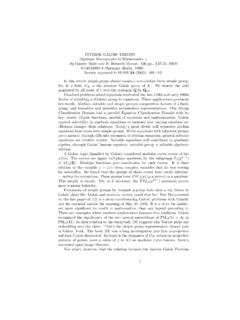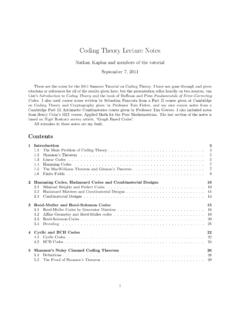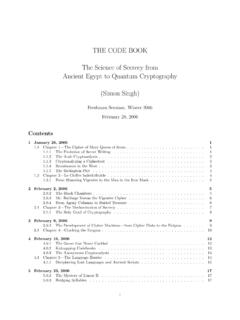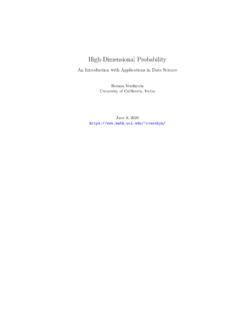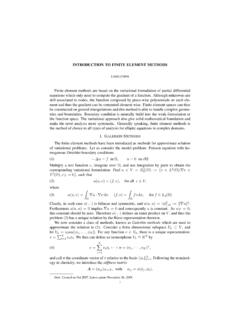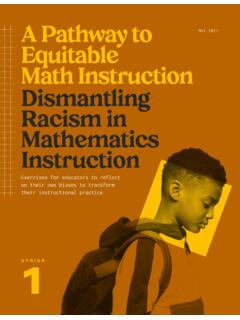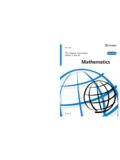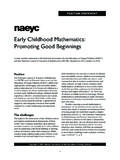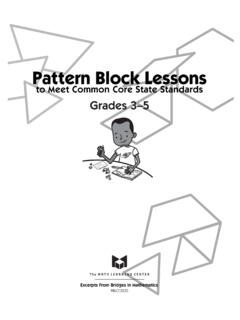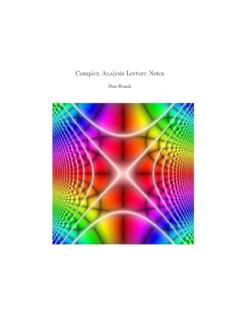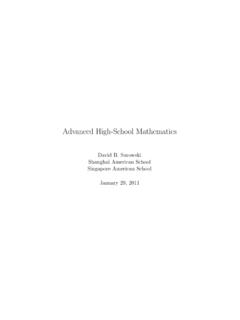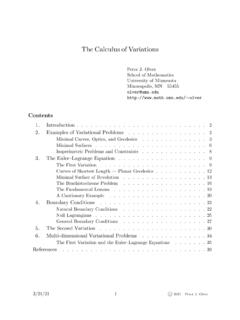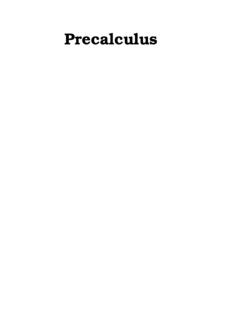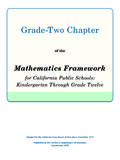Transcription of Math 13 — An Introduction to Abstract Mathematics
1 math 13 An Introduction to Abstract MathematicsNeil Donaldson & Alessandra PantanoJanuary 21, 2020 Contents1 Introduction32 Logic and the Language of .. of Proof ..363 Divisibility and the Euclidean and Congruence .. Common Divisors and the Euclidean Algorithm ..534 Sets and Notation and Describing a Set .. , Intersections, and Complements .. to Functions ..755 Mathematical Induction and Recursive Processes .. by Induction .. and the Principle of Mathematical Induction .. Induction .. 1056 Set Theory, Part Products .. Sets .. Collections of Sets .. 1197 Relations and .. revisited .. Relations .. , Rings and Congruence .. and Partitions .. 16018 Cardinalities of Infinite s Notion of Cardinality.
2 Sets .. 173 Useful Texts Book of Proof, Richard Hammack, 2nd ed 2013. Available free online! Very good on the basics: ifyou re having trouble with reading set notation or how to construct a proof, this book s for you!These notes aredeliberatelypitched at a high level relative to this textbook to provide contrast. Mathematical Reasoning, Ted Sundstrom, 2nd ed 2014. Available free online! Excellent you would like to buy the actual book, you can purchase it on Amazon at a really cheap price. Mathematical Proofs: A Transition to Advanced Mathematics , Chartrand/Polimeni/Zhang, 3rd Ed2013, Pearson. The most recent course text. Has many, many exercises; the first half is fairlystraightforward while the second half is much more complex and dauntingly detailed. The Elements of Advanced Mathematics , Steven G.
3 Krantz, 2nd ed 2002, Chapman & Hall andFoundations of Higher Mathematics , Peter Fletcher and C. Wayne Patty, 3th ed 2000, Brooks Coleare old course textbooks for math 13. Both are readable and concise with good Outcomes1. Developing the skills necessary to read and practice Abstract Understanding the concept of proof, and becoming acquainted with several proof Learning what sort of questions mathematicians ask, what excites them, and what they arelooking Introducing upper-division Mathematics by giving a taste of what is covered in several areas ofthe the way you will learn new techniques and concepts. For example:Number TheoryFive people each take the same number of candies from a jar. Then a group ofseven does the same. The, now empty, jar originally contained 239 candies.
4 Can you decidehow much candy each person took?Geometry and TopologyHow can we visualize and compute with objects like the Mobius strip?FractalsHow to use sequences of sets to produce objects that appear the same at all Infinity and Beyond!Why are some infinities greater than others?1 IntroductionWhat is Mathematics ?For many students this course is a game-changer. A crucial part of the course is the acceptance thatupper-division Mathematics is very different from what is presented at grade-school and in the cal-culus sequence. Some students will resist this fact and spend much of the term progressing throughthe various stages of grief (denial, anger, bargaining, depression, acceptance) as they discover thatwhat they thought they excelled at isn t really what the subject is about.
5 Thus we should start at thebeginning, with an attempt to place the Mathematics you ve learned within the greater context of original Greek meaning of the wordmathematais the supremely unhelpful, That which is tobe known/learned. There is no perfect answer to our question, but a simplistic starting point mightbe to think of your Mathematics education as a CalculusAbstract MathematicsIn elementary school you largely learnarithmeticand the basic notions of shape. This is the mathe-matics all of us need in order to function in the real world. If you don t know the difference between15,000 and 150,000, you probably shouldn t try to buy a new car! For the vast majority of people,arithmetic is the only Mathematics they ll ever need. Learn to count, add, and work with percent-ages and you are thoroughly equipped for most things life will throw at discusses the relationship between a quantity and its rate of change, the applicationsof which are manifold: distance/velocity, charge/current, population/birth-rate, etc.
6 Elementarycalculus is all about solving problems: What is the area under the curve? How far has the projec-tile traveled? How much charge is in the capacitor? By now you will likely have computed manyintegrals and derivatives, but perhaps you have not looked beyond such computations. A mathe-matician explores the theory behind the calculations. From an Abstract standpoint, calculus is thebeautiful structure of the Riemann integral and the Fundamental Theorem, understandingwhywecan use anti-derivatives to compute area. To an engineer, the fact that integrals can be used to modelthe bending of steel beams is crucial, while this might be of only incidental interest to a mathemati-cian. Perhaps the essential difference between college calculus and Abstract Mathematics is that theformer is primarily interested in theutilityof a technique, while the latter focuses on structure, ve-racity and the underlying beauty.
7 In this sense, Abstract Mathematics is much more of an art than ascience. No-one measures the quality of a painting or sculpture by how useful it is, instead it is thestructure, the artist s technique and the quality of execution that are praised. Research mathemati-cians, both pure and applied, view Mathematics the same areas of Mathematics other than Calculus, the link to applications is often more tenuous. Thestructure and distribution of prime numbers were studied for over 2000 years before, arguably, anyserious applications were discovered. Sometimes a real-world problem motivates generalizationsthat have no obvious application, and may never do so. For example, the geometry of projecting3D objects onto a 2D screen has obvious applications (TV, computer graphics/design).
8 Why wouldanyone want to consider projections from 4D? Or from 17 dimensions? Sometimes an applicationwill appear later, sometimes reason the mathematician studies such things is because thestructure appears beautiful to them and they want to appreciate it more deeply. Just like a are very useful applications of high-dimensional projections, not least to economics and the understanding ofsound and light Mathematics you have learned so far has consisted almost entirely of computations, withthe theoretical aspects swept under the rug. At upper-division level, the majority of mathematicsis presented in an Abstract way. This course will train you in understanding and creating abstractmathematics, and it is our hope that you will develop an appreciation for essential concept in higher-level Mathematics is that basic dictionary entry for theword would cover two meanings:1.
9 An argument that establishes the truth of a A test or trial of an Mathematics we always mean the former, while in much of science and wider culture the secondmeaning predominates. Indeed Mathematics is one of the very few disciplines in which one cancategorically say that something reality we can rarely be so certain. A greasy sales-man in a TV advert may claim that to haveprovedthat a certain cream makes you look younger; adefendant may beprovedguilty in court; the gravitational 2. Ask yourself whatthese statements mean. The advert is just trying to sell you something, but push harder and theymight provide some justification: 100 people used the product for a month and 75 of them claimto look younger. This is atest,a proof in the second sense of the definition. Is a defendant reallyguilty of a crime just because a court has found them so; have there never been any miscarriagesof justice?
10 Is the gravitational constant precisely 2, or is this merely a good approximation?This kind of pedantry may seem over the top in everyday life: indeed most of us would agree thatif 75% of people think a cream helps, then it probably is doing something beneficial. In mathematicsand philosophy, we think very differently: the concepts of true and false and of proof are very how do mathematicians reach this blissful state where everything is either right or wrong and,once proved, is forever and unalterably certain? The answer, rather disappointingly, is by Mathematics is true except with reference to some assumption. For example, consider thefollowing theorem:Theorem sum of any two even integers is all believe that this is true, but can weproveit? In the sense of the second definition of proof,it might seem like all we need to do is to test the assertion: for example 4+6=10 is even.


